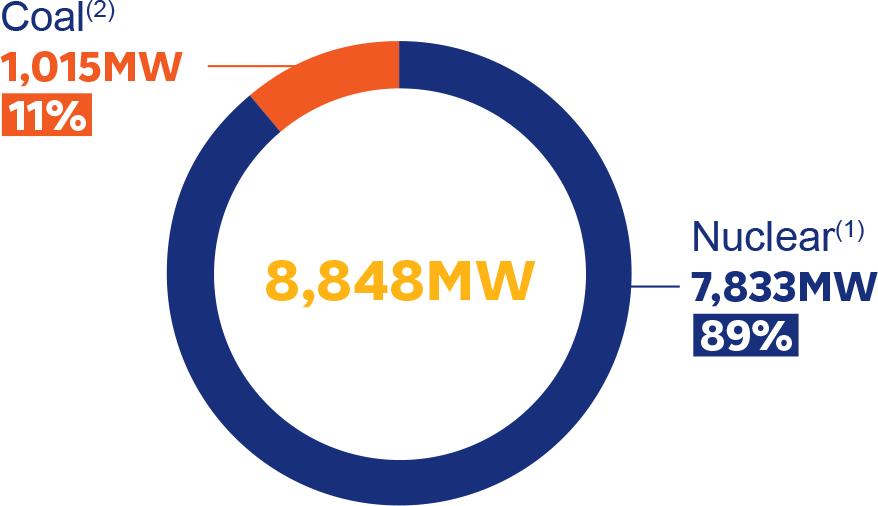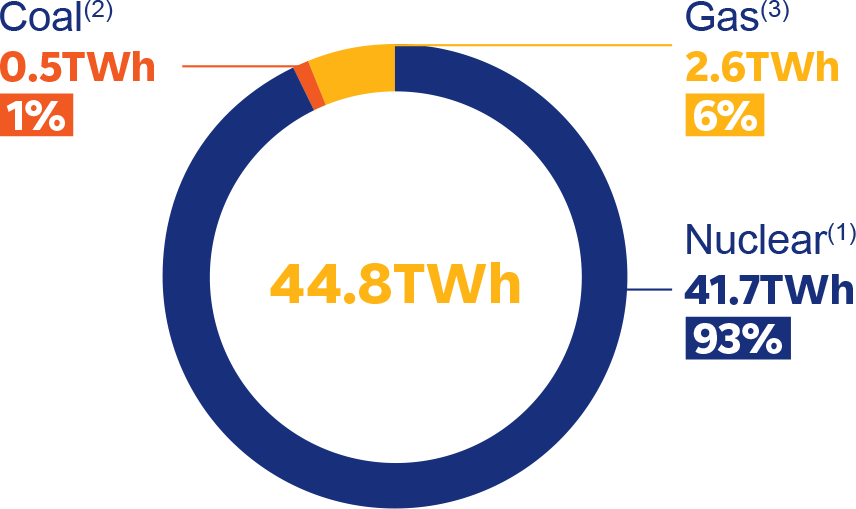1.4.5.1.2 Activities of EDF Energy
Installed capacity and output of EDF Energy in the United Kingdom – 2021
Installed capacity

8,848MW
- Coal(2) 1,015MW 11%
- Nuclear(1) 7,833MW 89%
Electricity output

44.8 TWh
- Coal(2) 0.5TWh 1%
- Gas(3) 2.6TWh 6%
- Nuclear(1) 41.7TMh 93%
(1) The figures shown represent 100% of nuclear capacity and generation output, shared 80%/20% by EDF and Centrica.
(2) Coal capacity represents transmission entry capacity.
(3) Including 1.35MW of Barkantine CHP.
NB : The values take into account rounding.
| EDF Energy | 31/12/2021 | 31/12/2020 |
|---|---|---|
| Electricity supplied (1) (in GWh) | Electricity supplied (1) (in GWh)31/12/2021 43,372 |
Electricity supplied (1) (in GWh)31/12/2020 40,850 |
| Gas supplied (in GWh) | Gas supplied (in GWh)31/12/2021 36,032 |
Gas supplied (in GWh)31/12/2020 29,462 |
| Number of residential customer accounts (in thousands) (2) | Number of residential customer accounts (in thousands) (2)31/12/2021 5,512 |
Number of residential customer accounts (in thousands) (2)31/12/2020 4,837 |
| Number of employees (3) | Number of employees (3)31/12/2021 11,141 |
Number of employees (3)31/12/2020 11,717 |
| Total Recordable Incident Rate (4) | Total Recordable Incident Rate (4)31/12/2021 0.71 |
Total Recordable Incident Rate (4)31/12/2020 0.59 |
| Total number of sockets (Pod Point) | Total number of sockets (Pod Point) 31/12/2021 153,677 |
Total number of sockets (Pod Point) 31/12/2020 91,610 |
(1) Power supplied to final consumer including previous year metering cut-offs.
(2) Year-end Figure.
(3) Headcount at the end of the period, including staff on maternity leave. Pod Point employees not included.
(4) Total Recordable Incident Rate: Annual total combined number of Lost Time Incidents, fatalities, Restricted Work Injuries and Medical Treatment Injuries (excluding First Aid)/number of hours worked ×1,000,000. This covers all employees, agency and contractor staff. Excludes EDF Renewables UK and Hinkley Point C project. Accident Frequency Rate (AFR) for HPC is 0.062 at end December 2021.
1.4.5.1.2.1 Regulatory regime applicable to nuclear facilities in the UK
The following regime is applicable to both EDF Energy’s generation and new build assets in the UK.
Regulatory notice
Basic nuclear facilities in the United Kingdom
In the United Kingdom, EDF Energy is required, under the Nuclear Installations Act 1965 (“NIA 1965”), to hold a nuclear site licence for each of its existing nuclear power plants and nuclear power plants under development and comply with a certain number of licence conditions. The Planning Act 2008 (“PA 2008”) introduced the concept of Development Consent Orders (“DCOs”), which are the authorisations required to build a new nuclear power plant in the UK. The DCO application process involves conducting an environmental impact assessment, implementing environmental mitigation measures and holding a certain number of public consultations.
Office for Nuclear regulation (ONR)
In the United Kingdom, the Office for Nuclear regulation (ONR) and the Environment Agency (EA)/Scottish Environment Protection Agency (SEPA) are responsible for the safety, security, emergency planning and environmental regulation that applies to the UK’s nuclear sites.
The ONR is responsible for the regulation and inspection of nuclear facilities and the following laws are overseen by the ONR:
- the Health and Safety at Work Act 1974 (HSWA 1974), which defines EDF’s obligations for the safety of workers and others on its sites;
- the Nuclear Installations Act 1965 (NIA 1965), under which operators of nuclear power plants need to obtain a nuclear site licence, comply with that licence and maintain nuclear liability insurance;
- the Energy Act 2013 (Part 3) (EA 2013) conferred statutory body status on the ONR. It also confirmed ONR’s purposes in respect of nuclear safety, nuclear site health and safety, nuclear security, nuclear safeguards and transport. Schedule 8 of the Act details the powers of ONR Inspectors;
- the Ionising Radiation regulations 2017 (IRR 2017), which are based on the Basic Safety Standards Directive and provide for the protection of workers and the public against ionising radiation;
- the Environmental Permitting (England and Wales) regulations 2016 and the Environmental Authorisations (Scotland) regulations The 2016 regulations provide the current permitting framework for radioactive substances. The 2018 regulations provide a framework for the authorisation of environmental activities and currently include only Radioactive Substances activities. The EA and SEPA are the responsible regulators for these 2016 and 2018 regulations respectively.
When assessing the measures that may be required to reduce the risks from activities within the scope of HSWA 1974, the ONR requires risks to be reduced as low as reasonably practicable.
The ONR uses the powers granted to it under the NIA 1965, the EA 2013 and the 36 standard Nuclear Site Licence Conditions as the basis for its monitoring and enforcement regime. The ONR has extensive inspection powers allowing it to inspect nuclear facilities, request documents and conduct investigations. It begins with a detailed review and assessment of the safety of the design and continues throughout the operation and decommissioning of the facilities.
Under the NIA 1965, the ONR is authorised to grant licences to applicants and to impose licence conditions which may be varied or revoked. In particular, the ONR can prohibit certain nuclear operations or revoke the licence of a nuclear site. More commonly, the ONR may agree to specific actions, approve arrangements or require changes/variations to operations. The maximum penalty for non-compliance with safety legislation is an unlimited fine or imprisonment for a term not exceeding two years for directors or both.
